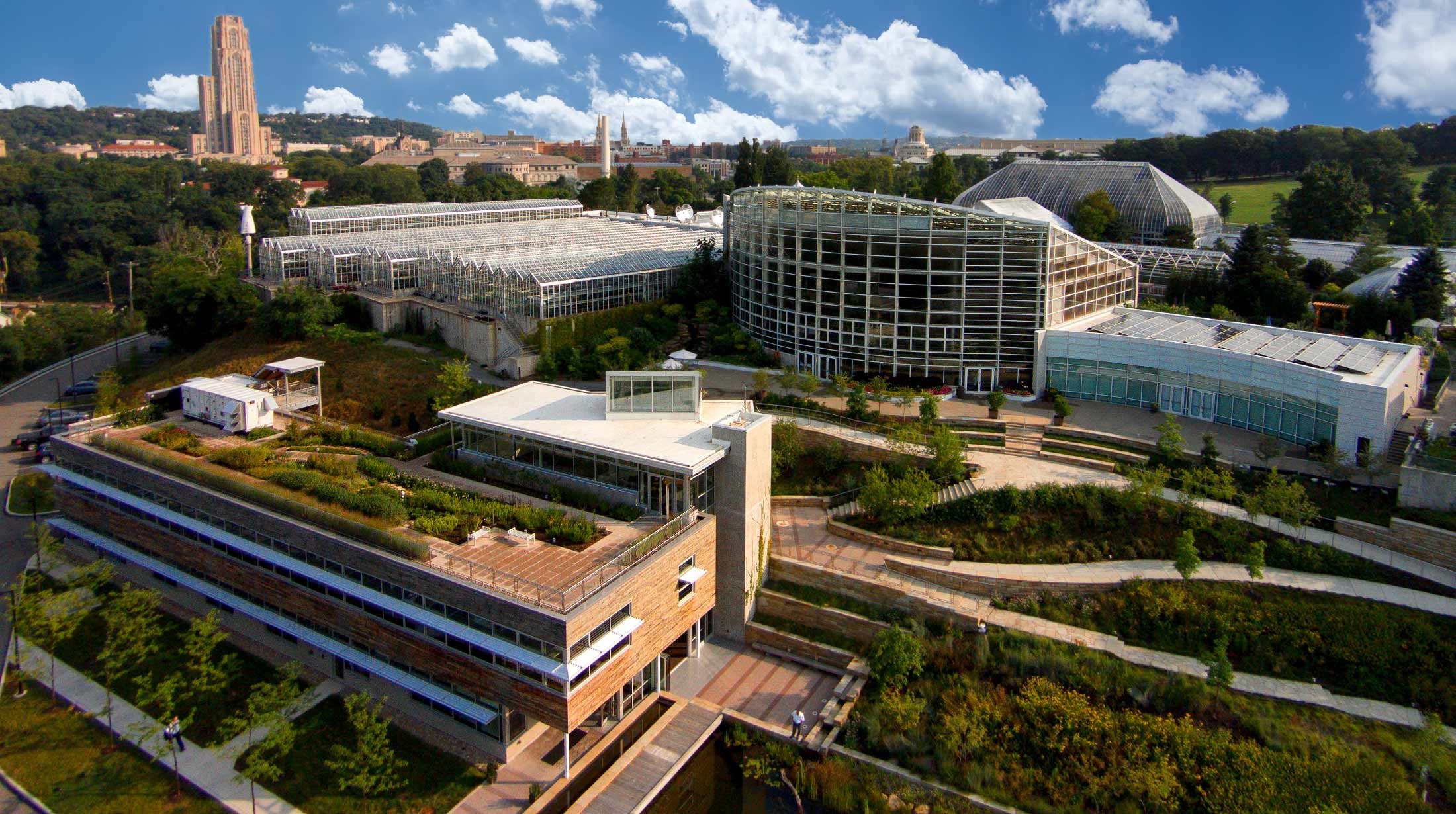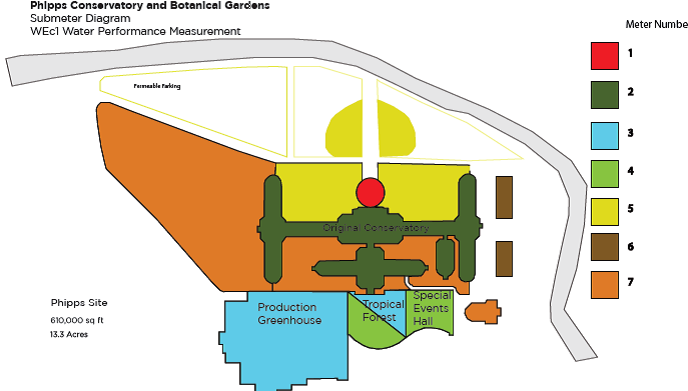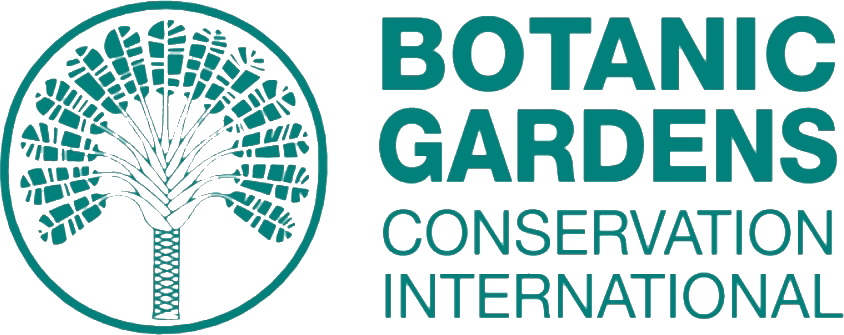நீர் திறன்: ஒரு வழக்கு ஆய்வு

தாவரவியல் பூங்காக்கள் தாவர வாழ்க்கையை ஆதரிக்க தேவையான அத்தியாவசிய ஆதாரங்களில் நீர் ஒன்றாகும். தோட்டங்கள் தாவரங்களுக்கு நீர்ப்பாசனம் செய்ய வேண்டும், ஆனால் நாம் அதை ஒரு நிலையான முறையில் செய்ய வேண்டும். கழிவு நீரைக் குறைப்பதன் மூலம் நிலத்தடி நீர் ஓட்டம், சுற்றுச்சூழல் அமைப்புகள் மற்றும் நீர்த்தேக்கங்கள், குறைந்த நிதிச் செலவுகள் மற்றும் காலநிலை மாற்றத்தை நிவர்த்தி செய்வதன் மூலம் ஆற்றல்-தீவிர சுத்திகரிப்பு தேவையைக் குறைப்பதன் மூலம் மேம்படுத்தலாம். இந்த காரணங்களுக்காக, காலநிலை கருவித்தொகுப்பு சமீபத்தில் சேர்க்கப்பட்டது இரண்டு புதிய இலக்குகள் நீர் மேலாண்மையுடன் நேரடியாக தொடர்புடையது. இந்த இலக்குகளை நீங்கள் அடைந்திருந்தால் அல்லது அடைய திட்டமிட்டிருந்தால், தயவுசெய்து எங்களுக்கு தெரியப்படுத்துங்கள் எனவே இந்த தகவலை தரவுத்தளத்தில் சேர்க்கலாம்!
ஃபிப்ஸ் கன்சர்வேட்டரி பயன்படுத்தப்பட்டது நீர் அளவீடு அவர்களின் நீர் நுகர்வு பகுப்பாய்வு மற்றும் கசிவு மேலாண்மை அவர்களின் நீர் இழப்பைக் குறைக்க. இந்தக் கட்டுரையில், நீர் திறன், திட்ட வரைவு நீர் உத்திகள், EPA நீர் பாதுகாப்பு உத்திகள் மற்றும் தாவரவியல் பூங்காவிற்குள் நீர் அளவீடுகள் ஆகியவற்றை வரையறுத்து, பிப்ஸ் கன்சர்வேட்டரியின் நீர்க் கழிவுகளைக் கணிசமாகக் குறைக்க இந்த அமைப்பு எவ்வாறு உதவியது என்பதை விளக்கப் போகிறோம்.
திட்ட வரைவு: கசிவு மேலாண்மை
காலநிலை குறித்த முக்கியமான தகவல்களை வெளியிடுவதன் மூலம் உலகளாவிய கார்பன் உமிழ்வைக் குறைப்பதில் திட்ட டிராடவுன் கவனம் செலுத்துகிறது தீர்வுகள். இலாப நோக்கற்ற நிறுவனம் போக்குவரத்து, மின்சாரம், உணவு மற்றும் விவசாயம், சுகாதாரம் மற்றும் கல்வி, தொழில் மற்றும் கட்டிடங்கள் போன்ற பிற தலைப்புகளில் தீர்வுகளை வெளியிட்டுள்ளது. திட்ட வரைவுக்குள் பட்டியலிடப்பட்டுள்ள சிக்கல்களில் ஒன்று நீர் விநியோக திறன் இது "நீர் விநியோக நெட்வொர்க்குகளில் கசிவுகளை நிவர்த்தி செய்கிறது." விநியோக அமைப்பில் வெவ்வேறு பயனர்களுக்கு பம்ப் செய்யும் போது குறிப்பிடத்தக்க அளவு தண்ணீர் இழக்கப்படுகிறது. நீர் பயன்பாட்டு நிறுவனங்கள் தங்கள் கணினி முழுவதும் தண்ணீரை பம்ப் செய்ய மின்சாரத்தைப் பயன்படுத்துகின்றன, இதன் விளைவாக மின்சாரத்தின் மிகப்பெரிய நுகர்வோர் ஒன்றாகும். கசிவுகள் மற்றும் விரிசல்கள் அதிக மின்சாரத்தைப் பயன்படுத்துவதால் இழந்ததை மாற்றுவதற்கு கணிசமான அளவு தண்ணீரை குழாய்கள் வழியாக மீண்டும் செலுத்தலாம். வளாகம் முழுவதும் நீர் செயல்திறனை அதிகரிக்க அழுத்தம் மேலாண்மை அல்லது செயலில் கசிவு கண்டறிதல் ஆகியவற்றைப் பயன்படுத்தி திட்ட டிராடவுன் பரிந்துரைக்கிறது.
கசிவுகள் நீர் அளவீடு, கசிவு கண்டறிதல் மற்றும் அழுத்தம் மேலாண்மை உள்ளிட்ட பல்வேறு முறைகளைப் பயன்படுத்தி கண்டறியலாம். ஒரு நிறுவனம் அழுத்தம் வால்வுகளை நிறுவினால், கசிவுகள் மற்றும் விரிசல்களைக் கண்டறிந்து, ஆய்வு செய்து சீல் வைக்கலாம். அழுத்தம் மேலாண்மை மற்றும் செயலில் கசிவு கண்டறிதல் துல்லியமாக பயன்படுத்தப்பட்டால், திட்ட டிராடவுன் நீர் இழப்பை "2050 ஆம் ஆண்டளவில் உலகளவில் 38 - 47 சதவிகிதம் கூடுதலாக குறைக்க முடியும்" என்று மதிப்பிடுகிறது. கழிவு நீரைக் குறைப்பது தற்போதைய கார்பன் உமிழ்வைக் குறைக்கும் அதே வேளையில் மூலதனத்தை கணிசமாக சேமிக்கும்.
EPA செயல்திறன் உத்திகள்: நீர் அளவீடு
EPA ஆனது நீர்ச் செயல்திறனுக்கான சிறந்த நடைமுறைகள் பற்றிய வழிகாட்டியை வெளியிட்டது: நீர் அமைப்பு மேலாண்மை, கசிவு மேலாண்மை, அளவீடு, பாதுகாப்பு விகித அமைப்பு, இறுதி பயன்பாட்டு நீர் பாதுகாப்பு மற்றும் திறன் பகுப்பாய்வு, மற்றும் நீர் பாதுகாப்பு மற்றும் திறன் திட்டம் ஆகியவை அடங்கும்.
நீர் அளவீடு ஒரு அமைப்பில் நீரின் ஓட்டத்தை அளவிடுவது என வரையறுக்கலாம் மற்றும் நீர்ப்பாசனம் மற்றும் நீர் செயலாக்கத்திற்கு பயன்படுத்தப்படும் நீரின் அளவைக் கண்காணிக்கவும் அளவிடவும் வடிவமைக்கப்பட்டுள்ளது. நீர் அளவீடு பயனர்கள் நீங்கள் எவ்வளவு தண்ணீரைப் பயன்படுத்துகிறீர்கள், எங்கு பயன்படுத்துகிறீர்கள் என்பதைப் புரிந்துகொள்ள உதவுகிறது, இது நீர் பயன்பாட்டைக் குறைக்கும் வழிகளை நீங்கள் திட்டமிட உதவும்.
பிப்ஸ் கன்சர்வேட்டரி
பிட்ஸ்பர்க்கில் ஒருங்கிணைந்த கழிவுநீர் அமைப்பைக் கொண்டிருப்பது தொடர்பான பிரச்சனைகளைத் தீர்ப்பதற்கு தண்ணீரைப் பாதுகாப்பது அவசியம். கணிசமான அளவு மழை பெய்யும் போது, அமைப்பு கழிவுநீர் மற்றும் மழையை உள்ளூர் ஆறுகளில் நிரம்பி வழிகிறது. மழைவீழ்ச்சியிலிருந்து அனைத்து நீரையும் சேமிப்பது மற்றும் சுகாதார மற்றும் நகராட்சி தண்ணீரை மீண்டும் பயன்படுத்துவது இதைத் தடுக்க அவசியம். பிப்ஸின் நீர் அமைப்பு மூன்று பிரிவுகளாக வரிசைப்படுத்தப்பட்டுள்ளது: சுகாதாரம், நகராட்சி மற்றும் மழை நீர் . ஃபிப்ஸ் மழை பீப்பாய்கள், மழைத் தோட்டங்கள் மற்றும் ஒரு தடாகம் ஆகியவற்றைப் பயன்படுத்தி தண்ணீரைப் பிடிக்கிறது. சேமித்து வைக்கப்படும் நீர் அவற்றின் தாவரங்களுக்கு நீர்ப்பாசனம் செய்ய பயன்படுத்தப்படுகிறது, செயல்பாட்டில் குடிநீரை சேமிக்கிறது. ஃபிப்ஸ் அதன் கீழ் வளாகத்தில் உள்ள மூன்று கட்டிடங்களில் இருந்து சுகாதார நீரை மறுசுழற்சி செய்கிறது, அதன் மூலம் ஈரநிலம் மற்றும் மணல் வடிப்பான்கள் கட்டப்பட்ட ஒரு குடியேற்ற தொட்டி மூலம் தண்ணீரை சுழற்றுகிறது. இறுதிக் கட்டமானது, சுத்தம் செய்யப்பட்ட நீரை புற ஊதா ஒளியைக் கடந்து, கழிவறைகளை ஃப்ளஷ் செய்ய மறுசுழற்சி செய்வதற்கு முன், நோய்க்கிருமிகளைக் கொல்லும்.
2012 இல், பிப்ஸ் வளாகம் முழுவதும் நீர் அளவீடு நிறுவப்பட்டது. ஃபிப்ஸின் நீர் அளவீட்டு அமைப்பு கன்சர்வேட்டரி முழுவதும் பரவியுள்ளது, இதனால் ஊழியர்கள் கசிவுகள் மற்றும் விரிசல்களை குறிவைக்க அனுமதிக்கிறது. பெரும்பாலான சந்தர்ப்பங்களில், நீர் அளவீடு பற்றிய ஆராய்ச்சி நகர்ப்புற அமைப்புகள் மற்றும் குடியிருப்பு பகுதிகளுக்குள் சாத்தியமான சேமிப்பு மற்றும் செயல்திறனைக் குறைப்பதில் கவனம் செலுத்துகிறது. ஃபிப்ஸ் கன்சர்வேட்டரி அவர்களின் நீர் அமைப்புகளை மேம்படுத்த தற்போதைய உள்கட்டமைப்பில் கவனம் செலுத்தியது.

நீர் அளவீட்டின் உதவியுடன், 2012 இல் கன்சர்வேட்டரி முழுவதும் மொத்தம் 12,050,000 கேலன் தண்ணீரைப் பயன்படுத்தியதை Phipps கண்டறிந்தது. மொத்த நீரில் 53% நீர் அம்சங்கள் மற்றும் செயல்முறை நீருக்காகவும், மொத்த நீரில் 44% பாசனத்திற்காகவும் பயன்படுத்தப்பட்டது. பிப்ஸ் அவர்களின் அமைப்பில் குறிப்பிடத்தக்க நீர் பற்றாக்குறை மற்றும் கழிவுகள் இருப்பதை உணர்ந்தனர். கணினியை முழுமையாக மறுகட்டமைப்பதற்குப் பதிலாக, தற்போதைய உள்கட்டமைப்பை மேம்படுத்துவதில் Phipps கவனம் செலுத்தியது. ஒட்டுமொத்த கழிவு நீரை குறைக்க கட்டுப்பாட்டு பலகைகள், டைமர்கள் மற்றும் லெவல் சென்சார்கள் ஆகியவற்றைக் கொண்ட மாதிரிகள் மூலம் நீர் அம்சங்களை மாற்றுவதை இந்தத் திட்டம் கொண்டிருந்தது. நீர் அளவீட்டிற்கு கூடுதலாக, கட்டுப்பாட்டு பலகைகள் கசிவுகள் மற்றும் விரிசல்களை எளிதில் அடையாளம் காண அனுமதிக்கின்றன. நீர் நுகர்வு Phipps இல் 45% குறைந்து சுமார் சேமிக்கப்பட்டது 5.5 மில்லியன் கேலன் தண்ணீர். Phipps அமைப்புகளையும் தொழில்நுட்பத்தையும் தொடர்ந்து மேம்படுத்துகிறது.
பரிந்துரைகள்
- Phipps பரிந்துரைக்கிறது பயன்படுத்தி லிவிங் பில்டிங் சவாலின் நீர் இதழ் கட்டுமானம் மற்றும் ஏற்கனவே உள்ள ரெட்ரோஃபிட்கள் பற்றிய வழிகாட்டுதலுக்காக.
- கழிவு நீரை குறைப்பதில் கவனம் செலுத்த வேண்டும் வளாகம் முழுவதும் நிதி சேமிப்பு அல்ல! முதலீட்டின் மீதான வருமானம் தண்ணீர் குறைப்புகளுக்கு பொருந்தாது, ஏனெனில் இது ஒவ்வொரு சிறிய இலக்கையும் ஒரே நேரத்தில் முடிக்கும் மெதுவான செயல்முறையாகும்.






அண்மைய பின்னூட்டங்கள்